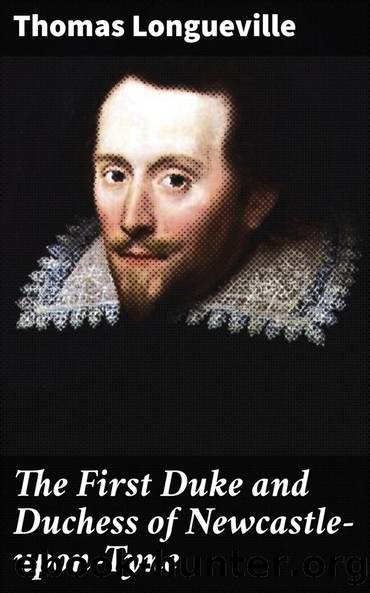The First Duke and Duchess of Newcastle-upon-Tyne by Thomas Longueville

Author:Thomas Longueville [Longueville, Thomas]
Language: eng
Format: epub
Tags: Classics, Nonfiction, Reference & Language, Reference, Fiction & Literature
ISBN: 4066338057259
Publisher: Good Press
Published: 2021-11-05T04:00:00+00:00
Having once started, the hitherto reluctant cavalry rode rapidly to the front. Rupert had arranged everything for his order of battle before going into York. The accounts of that order are rather conflicting; but, roughly speaking, it was something of this sort. The centre was composed mainly of infantry under Newcastle and King, or Lord Ethyn as he was now entitled. The right wing was formed of Rupertâs own cavalry, including his regiment of âold soldiers all, gentlemen who had seen much service in France and Spain,â Lord Byronâs Irish horse, Lord Grandisonâs horse, and some other cavalry, in all 7200 horse, drawn up in twelve divisions. The left wing contained about 4000 of Newcastleâs cavalry under Goring and Sir Charles Lucas, with a line of musketeers in front of them. The whole of the ditch was also lined with musketeers. A few guns were also posted in the ditch, and the rest of the artillery was placed on the flanks.
Confronting the Royalist centre was the Parliamentary infantry under Manchester and Leven. Opposite the Royalist right, the enemyâs left contained Cromwellâs âIronsides,â other cavalry of Manchesterâs and some Scottish horse; in all about 4200 horse, supported by 3000 foot soldiers. In front of the Royalist left the enemyâs right was made up of 4800 horse, consisting of Lord Fairfaxâs famous cavalry and some Scottish cavalry regiments, including the Ayrshire Lancersârather an uncommon armament at that period. In both armies reserves of cavalry and infantry were drawn up in the rear. The numbers in the opposing armies is doubtful; but probably they were pretty equal, and something over 20,000 on either side.
Rupert showed Ethyn a sketch of his position and asked him how he liked it. Ethyn replied that it was very fine on paper, but that it would not be so on the field. Rupert had placed his front rank close to the ditch, which was impassable in many places, and to this Ethyn strongly objected. Rupert replied, âThey may be drawn to a farther distanceâ. Ethyn, probably thinking that any retreat along the whole line would draw on an immediate attack from the enemy, replied, âNo, sir. It is too late.â
Rupert was very angry with Ethyn for saying this. They had not been on the best of terms beforehand, for Rupert thought that Ethyn, when General King, had not sufficiently supported him in a certain battle on the Continent. Rupert revenged himself upon Ethyn for finding fault with his order of battle on Marston Moor by twitting him when the engagement was over, for having been of very little use during the action.
In the course of the afternoon, a few shots were fired from the cannon of both armies; but without important results, although a captain was killed on each side; on one a nephew of Cromwell, on the other a son of Sir Gilbert Haughton. Some of the Puritan soldiers sang psalms, deriving considerable consolation from the psalmistâs denunciations of his enemies, which they mentally applied to what they called âthe Kingâs cursed and cursing cormorantsâ.
Download
This site does not store any files on its server. We only index and link to content provided by other sites. Please contact the content providers to delete copyright contents if any and email us, we'll remove relevant links or contents immediately.
Evelina by Fanny Burney(26795)
Evelina, Or, the History of a Young Lady's Entrance into the World by Fanny Burney(26231)
Twilight of the Idols With the Antichrist and Ecce Homo by Friedrich Nietzsche(18501)
Pale Blue Dot by Carl Sagan(4907)
The Perks of Being a Wallflower by Stephen Chbosky(4568)
Dune 01 Dune by Frank Herbert(4312)
Double Down (Diary of a Wimpy Kid Book 11) by Jeff Kinney(4204)
Man and His Symbols by Carl Gustav Jung(4066)
Walking by Henry David Thoreau(3892)
Separate Beds by LaVyrle Spencer(3768)
Ficciones by Jorge Luis Borges(3566)
FOUNDATION AND EMPIRE by Isaac Asimov(3548)
The 101 Dalmatians by Dodie Smith(3451)
Mystery at School by Laura Lee Hope(3369)
Anna and the French Kiss by Stephanie Perkins(3316)
120 Days of Sodom by Marquis de Sade(3177)
Some Prefer Nettles by Tanizaki Junichiro(2841)
The Little Prince by Antoine de Saint-Exupéry(2826)
My Ántonia by Willa Cather(2795)
